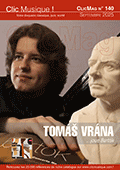 Alors que la seconde guerre mondiale le prive de diplômes, Sylvano Bussotti (1931-2021) approfondit ultérieurement ses études de composition en autodidacte, lui qui dessine et peint, tout comme il joue du piano, est récitant puis acteur, au théâtre, à la télévision et au cinéma (ce touche-à-tout, qui revendique l’union des arts et est fan des happenings de Fluxus ou du Living Theater – qu’il fréquente d’ailleurs en 1968 –, est aussi metteur en scène, scénographe, décorateur ou costumier) – après 1965, sa production musicale se concentre essentiellement sur des pièces de théâtre musical. Pour guitare, un instrument qui compte pour lui comme compte la flûte, il laisse ces pièces, pour l’interprétation desquelles Brilliant Classics fait confiance au guitariste italien Alberto Mesirca, à la technicité prononcée mais qui sait ce que transmettre une émotion veut dire – la voix, récitante, de Luca Scarlini complète le potentiel narratif de l’instrument, axe central du disque. (Bernard Vincken)  Sylvano Bussotti (1931-2021) counts among the most original and underappreciated composers working in the second half of the last century. He became famous – notorious – in the 1960s for ‘graphic’ scores which required considerable realisation on the part of the performer. His early work, however, is invested with a rhythmic regularity, a clarity of phrase structure and a lyricism reminiscent of Luigi Dallapiccola. Pierre Boulez saw Bussotti as an anachronism when they met and (in the composer’s recollection ‘completely rejected everything that I had written so far, compositions in his view largely influenced by that lyrical mediterranean dodecaphonic style which he particularly detested.’ In retrospect Bussotti’s music takes its place alongside that of his elder Italian contemporary Bruno Maderna as a oblique and distinctively Italian, discursive and colourful view over the variegated and sometimes alienated landscape of postwar serialism. Beyond The Rara Requiem, recorded by Sinopoli for DG, most of Bussotti’s large-scale projects such as a ‘Passion according to Sade’ have so far failed to find a place in the record catalogues, where he is mostly represented by various pieces with or for the flute. However, Bussotti also wrote prominently for the guitar throughout his career. This new album from Alberto Mesirca is the most complete survey yet recorded, beginning with Ermafrodito (1999), a ‘mythological fantasy’ for guitar which evokes a magical ballet with a body that gradually emerges in the background and takes over the scene. Bussotti’s other substantial work for guitar is Ultima rara (Pop Song), which from the beginning undermines the promised concept of ‘last things’ with a teasing textual commentary (spoken here by Luca Scarlini) and a playful use of the kind of refrain which extends pop songs beyond the organic life of their material. Shorter pieces include the light-heated and tuneful Popolaresca, as well as a reflective take on neoclassicism, Nuvola Barocca. The album closes with a brief tribute to Bussotti on his 60th birthday from Toru Takemitsu.
 |
